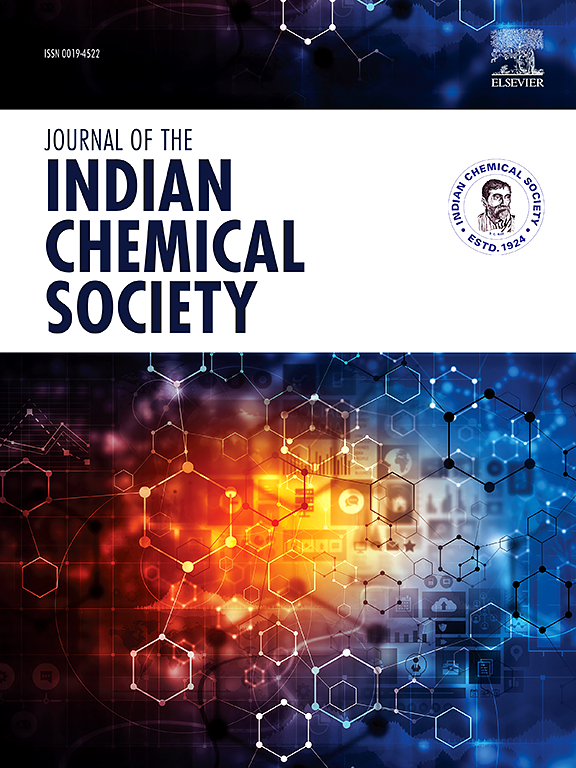Influence of surface charged Al2·67O4 nanofiller on conductivity and stability in plasticized green hydroxypropyl methylcellulose/pectin incorporated with LiClO4 polymer composite electrolyte
IF 3.2
4区 化学
Q2 CHEMISTRY, MULTIDISCIPLINARY
引用次数: 0
Abstract
In essence, the green polymer electrolyte with cationic deficient insulating oxide nanofillers gaining importance due to their significant influence on enhancing ionic conductivity and electrochemical stability. Specifically, in this work, the spinel Al2·67O4 nanoparticles were synthesized via solution combustion technique and free standing 10 wt % pectin/90 wt % Hydroxypropyl methylcellulose/25 wt % Glycerol/10 wt% spinel Al2·67O4/7.5 wt % LiClO4 solid polymer electrolyte has been fabricated via solution casting technique. X-ray diffraction pattern of calcined aluminum oxide reveals a cation-deficient cubic Al2·67O4 spinel phase, with an average crystallite size of 5.08 nm and a strain of 0.77 %, while the polymer electrolyte shows major amorphous nature even with the nanofiller. ATR-FTIR studies have confirmed the types of functional groups in the polymer chain. Thermal differential scanning calorimetry analysis shows that the prepared electrolytes exhibit endothermic peak at 46 °C corresponds to the Transition temperature (Tg). The surface of the optimized polymer electrolyte became rougher, with randomly spread nano pores as nanofiller and salts are added. Further, the electrolyte exhibits a maximum conductivity of 0.11 mScm−1 with a good stability window of 3.36 V and a maximum cation transference number of 0.74. Dielectric spectroscopic studies confirm that nanofillers are involved in enhancing the flexibility of the polymer electrolyte with a lower tangent loss and dielectric relaxation time at higher frequencies. The structural relaxation time associated flexible motion of chains found to decrease from 179.6 to 3.17 μs with the addition of Li salt. The mechanical tensile strength of the optimized polymer electrolyte with salt found to be 11.28 MPa with lower stiffness and higher young's modulus of 551.02 MPa.

表面带电Al2·67O4纳米填料对LiClO4聚合物复合电解质增塑绿色羟丙基甲基纤维素/果胶电导率和稳定性的影响
从本质上讲,缺乏阳离子的绝缘氧化物纳米填料的绿色聚合物电解质因其对提高离子电导率和电化学稳定性的重要影响而受到重视。具体而言,本文采用溶液燃烧技术合成了尖晶石Al2·67O4纳米颗粒,并通过溶液铸造技术制备了10 wt%果胶/90 wt%羟丙基甲基纤维素/25 wt%甘油/10 wt%尖晶石Al2·67O4/7.5 wt% LiClO4固体聚合物电解质。煅烧后的氧化铝的x射线衍射图显示为缺乏阳离子的立方Al2·67O4尖晶石相,平均晶粒尺寸为5.08 nm,应变为0.77%,而聚合物电解质即使有纳米填料也表现为非晶态。ATR-FTIR研究证实了聚合物链中官能团的类型。热差扫描量热分析表明,制备的电解质在46℃处出现吸热峰,对应于转变温度(Tg)。优化后的聚合物电解质表面变得粗糙,随着纳米填料和盐的加入,纳米孔随机分布。此外,电解质的最大电导率为0.11 mScm−1,具有3.36 V的良好稳定窗,最大阳离子转移数为0.74。电介质光谱研究证实,纳米填料参与提高聚合物电解质的柔韧性,具有更低的正切损耗和更高频率下的介电弛豫时间。随着Li盐的加入,与链的柔性运动相关的结构弛豫时间从179.6 μs减小到3.17 μs。优化后的含盐聚合物电解质的力学抗拉强度为11.28 MPa,刚度较低,杨氏模量较高,为551.02 MPa。
本文章由计算机程序翻译,如有差异,请以英文原文为准。
求助全文
约1分钟内获得全文
求助全文
来源期刊
CiteScore
3.50
自引率
7.70%
发文量
492
审稿时长
3-8 weeks
期刊介绍:
The Journal of the Indian Chemical Society publishes original, fundamental, theorical, experimental research work of highest quality in all areas of chemistry, biochemistry, medicinal chemistry, electrochemistry, agrochemistry, chemical engineering and technology, food chemistry, environmental chemistry, etc.

 求助内容:
求助内容: 应助结果提醒方式:
应助结果提醒方式:


